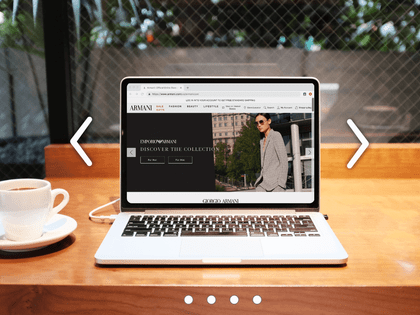How Website Carousels are hurting your UX (User Experience)

How often have you browsed online, only to land on a webpage with a series of moving slides to greet you? We’re talking about “carousels” that automatically advance through a series of visuals and messages without any obvious way to stop them. While, at times, they might capture the attention of a few, there is a lot more to web design than flashy automatic elements that can sabotage the user experience.

You're not alone if you think carousels are distracting when you land on a website. In fact, many web design and UX experts and users share your sentiment. This article will provide a breakdown of the public's thoughts on carousels.
“Simply put, if you’re using a carousel, you’re wasting incredibly valuable above-the-fold real estate.” - the good.com
The Arguments Against Website Carousels
- They’re distracting and annoying: The automatic movement of carousel slides can be visually jarring and interrupt users' focus on the rest of the page.
- Reduced visibility: Users might miss important information if they don't have time to read it before the slide changes.
- Accessibility concerns: People with disabilities, such as motor or cognitive impairments, might find it difficult to control or interact with the carousel.
- Banner blindness: Users often develop "banner blindness," meaning that they tune out the auto-playing content altogether, making the carousel ineffective. This is a problem if the information on carousel slides is critically important in defining what a company or organization offers.
- Performance impacts: Autoplay can add unnecessary code and scripts, slowing page load times.

The Arguments In Favor of Website Carousels (used sparingly)
- Visually appealing: When designed well, they can be visually attractive and showcase multiple images or content in a limited space.
- Highlights key information: They can effectively draw attention to important promotions or updates if used strategically.
- Mobile adaptability: They can work well on mobile devices with careful design and user control.
How to Use Carousels (if you must)
Sometimes, a carousel ends up being an acceptable solution for a site. If that’s the case, remember that user control is crucial. Always provide clear and easily accessible navigation buttons for users to pause, advance, or rewind the carousel at their own pace. Also, keep in mind to:
- Keep the carousel short and sweet: Limit the number of slides and the transition speed to avoid overwhelming users.
- Prioritize accessibility: Ensure the carousel is accessible to users with disabilities using appropriate markup and keyboard navigation.
- Measure its effectiveness: Track user engagement with the carousel to see if it achieves its intended goals and does not create an annoying customer experience.
The general consensus among web users is that carousels should be used cautiously and only when a clear benefit outweighs the potential drawbacks. In many cases, alternative design solutions that offer users more control and avoid accessibility issues are likely more effective.
A website should prioritize user experience, which often means putting control in the user's hands.
So what should be used instead?
There are several excellent alternatives to carousels that improve user experience and promote better engagement on your client's website:
Focus on Clarity and Control
- Static hero image or video: Choose a single impactful image or video that effectively conveys the website's message and brand identity. Offer a clear call to action alongside it.
- Tabbed content: Divide your key content into easily accessible tabs that users can switch between at their own pace.
- Accordions: Use accordions to reveal content on demand, especially for longer sections or less critical information.
- Grid layout: Showcase multiple items in a visually appealing grid, allowing users to scan and select what interests them.
- Interactive sliders: Implement user-controlled sliders that enable visitors to browse content at their desired speed and focus.
Prioritize Engagement and Accessibility
- Featured content with thumbnails: Highlight key content or products with static images and engaging titles. Thumbnails offer a preview and a clear path to explore further.
- Dynamic carousels: Opt for manual controls (arrows, dots, or thumbnails) and a clear pause option.
- Image galleries: Create dedicated image galleries for visual content, offering navigation and zoom features for better exploration.
- Prioritize accessibility: Ensure all alternatives meet accessibility standards using appropriate ARIA attributes, keyboard navigation, and clear labeling.
Other Considerations
- A/B testing: Analyze user behavior through A/B testing to see which format resonates best with your audience and achieves desired goals.
- Content quality: Regardless of the format, focus on delivering high-quality content that is relevant, informative, and visually appealing.
- Mobile responsiveness: Ensure all alternatives adapt seamlessly to different screen sizes and devices for optimal user experience across platforms.
By ditching distracting carousels and embracing user-friendly alternatives, you'll create a website that delights visitors, boosts engagement, and achieves your business goals. Remember, the user is always at the center, and their experience should be your top priority.
For more information about responsive, user-friendly web design, get in touch with one of our o8 experts.







